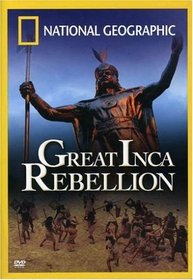| Genres: Television, Educational, Documentary Sub-Genres: Television, Educational, Documentary Studio: Nat'l Geographic Vid Format: DVD - Color,Widescreen - Closed-captioned DVD Release Date: 07/03/2007 Original Release Date: 01/01/2007 Theatrical Release Date: 01/01/2007 Release Year: 2007 Run Time: 0hr 50min Screens: Color,Widescreen Number of Discs: 1 SwapaDVD Credits: 1 Total Copies: 0 Members Wishing: 0 MPAA Rating: NR (Not Rated) Languages: English |
Search - National Geographic: The Great Inca Rebellion on DVD
  | National Geographic The Great Inca Rebellion Genres: Television, Educational, Documentary NR 2007 0hr 50min History reports that the mighty Inca were swiftly wiped out by a small band of Conquistadors. But, new evidence is being unearthed that may help re-write history. Remains of those who died in battle have been discovered, a... more » |
Larger Image |
Movie DetailsSimilar Movies
Similarly Requested DVDs
|
Movie ReviewsReading History from Bones Jeffery Mingo | Homewood, IL USA | 07/03/2007 (4 out of 5 stars) "A handful of corpses are found outside of Lima, Peru. The documentary asks what does the damage on the bodies of these Inca tell us about their deaths and the history of the Andes. It also asks whether these bones corroborate what the contemporary Spanish said about their victory in South America. This was a major look into forensics, very similar to what you might watch on "Court TV." Hawks may love this too as it speaks of battles and military strategy. I learned that Pisarro was illiterate; I never knew the command of a fleet to an unknown territory would be given to one who couldn't read. The documentary has diverse interviewees: Anglo Americans and Peruvians, men and women. The narrator says that based upon the bones behind the ear sections, experts could tell that some of the buried were female. I didn't know that could be learned from skulls; I thought the only signs of biological sex are height and pelvises. Natives fighting each other were dressed in either brown or maroon. I wonder if this is historically accurate or just done to make the modern viewer understand who was fighting whom. My suspicions tell me that some of the Inca actors were Americans entirely of European descent just dressed up. I wonder very much about the other side of the coin. What if this documentary were not titled "The Great Inca Rebellion," but instead "The Swift Spanish Suppression" or something like that? Who would want to watch it then and who would then ignore it? This documentary speaks of shot wounds to the face, severed fingers, and bludgeoned body parts, etc. This work may not be appropriate for children. Still, those who enjoyed "Apocalypto" may really enjoy seeing this too." More forensics than history J. S. Kaminski | Aberdeen, NJ United States | 07/20/2008 (3 out of 5 stars) "I found it odd that the title of this program is "The Great Inca Rebellion," as at least half of it, and maybe more, focuses on a detailed analysis of several human skeletons found in a makeshift graveyard outside of Lima, Peru. (The discussion is very thorough, e.g. Were these people shot? Were they killed with steel weapons, or stone? How exactly did they die? etc.) And while the bones may very well be those of some Inca that took part in the Siege of Lima in 1536, analyzing them and trying to determine how the people were killed is not quite telling the story of the rebellion itself.
When the program did get around to telling that story, I was more than a little disappointed. Reason? It treats the fact that the Spaniards had help from local natives in their struggle against the Inca as if this is some new revelation. While it is true that Spanish chroniclers failed to mention it, the idea that the Spanish had help has long been assumed by serious historians. In fact, in a book I own ("The Conquistadors" by Hammond Innes, published in 1969) the author addresses this exact situation: "...and though Spanish accounts make no reference to Indian allies there is little doubt that, like Cortes (facing the Aztecs), Pizarro took pains to augment his small force with local levies." Furthermore, the program fails to mention that the Inca empire had recently endured a civil war, and there was plenty of animosity still present between the various regions of the 3000-mile kingdom (think North vs. South). In short, the Inca empire was fragmented and there were many factions within it willing to fight each other. The Spaniards realized this and used it to their advantage when trying to subdue their enemies, including during the Great Rebellion of 1536. However, the program isn't all bad, and when it reveals that one of the skulls was determined to have a gunshot wound, it became interesting, as it is considered to be the earliest documented gunshot wound in the Americas. Still, I have to caution against the history as presented here. While it is accurate in its conclusion that the Spaniards had Indian help, the portrayal in this program that no one knew about it until now is seriously stretching the truth. The Spanish chroniclers may not have mentioned it at the time, but it has already been assumed for the past several decades, if not longer. Three stars." |















